Today we did some observations as part of the Great Sunflower Project. We signed up earlier in the year to participate and they sent us some seeds to plant in our garden. Our job was to observe the sunflowers once they bloom and count how many bees visited our flowers. You are asked to observe until you see five bees or for thirty minutes.
We did not have to wait even a minute before we saw our first bee! We had five bees observed in less than five minutes.
Here is one sunflower that is just unfolding its bloom. I love the way it looks.
I love the patterns in this sunflower. You can really see how it is a composite flower with its rays and florets.
This bee couldn’t wait for the sunflower to open…he had to push his way into the inside to reach the pollen.
Have you ever seen so much pollen on a bee before? I couldn’t stop watching this guy and his overloaded pollen sacs. Wow! He is one busy bee.
This is my favorite sunflower in the whole garden. We grew it from a seed saved from last year and it is a Mammoth Sunflower. It is really tall and the bloom is huge.
This is my son who is six feet tall….he is dwarfed by this sunflower. Look at how large the leaves are!
This is what the finches are doing to the leaves. They sit and nibble every afternoon. I guess there is enough to share.
This is a really fun and easy project. Check out the Great Sunflower Project for your family next year.




















